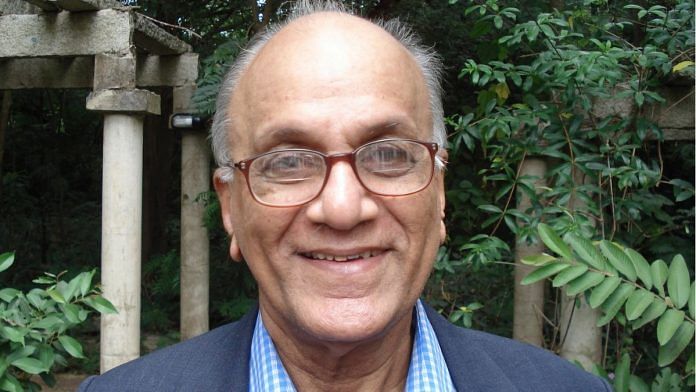Music and mathematics were the two constants in CS Seshadri’s life. But it was his work in algebraic geometry and contribution to mathematics that brought him the Padma Bhushan honour in 2009. He was elected Fellow of the Royal Society in 1988.
“If I had not taken up mathematics as my profession, I would have taken up music,” he had said in an interview with The Hindu.
His work in the field of algebraic geometry helped establish India’s contribution to mathematics on an international platform. An institute builder, Seshadri established the School of Mathematics at the Tata Institute of Fundamental Research (TIFR) in Mumbai and later, the Chennai Mathematical Institute (CMI).
His research on unitary vector bundles and his collaboration with mathematician MS Narasimhan to prove the necessary conditions for stable vector bundles on a Riemann surface—which came to be known as the Narasimhan–Seshadri theorem—and the Seshadri constant are some of his notable contributions.
From Chennai to France
Conjeevaram Srirangachari Seshadri was born on 29 February 1932, in Kanchipuram, a small temple town west of Chennai. He was the eldest of eleven children, a “cricket team” as he called it. Seshadri’s father C. Srirangachari was a well-known advocate in Chengalpattu, a town 60 km south of Chennai.
Seshadri completed his initial schooling in the town. In 1948, he joined Loyola College, Chennai.
During his years at Loyola his algebra professor, a Jesuit priest Charles Racine played a decisive role in Seshadri’s path towards mathematics as a profession. Fr. Racine had worked under an influential French mathematician Elie Cartan in Paris. He introduced Seshadri to the works of high-level French mathematicians such as Claude Chevalley and Jean-Pierre Serre.
Seshadri graduated in 1953 with a BA (honours) degree in mathematics after which he joined the TIFR, Mumbai as a student. He received his PhD in 1958 for his thesis titled ‘Generalised multiplicative meromorphic functions on a complex manifold’.
Seshadri shot to fame in 1957 on a trip to France. French mathematician Serre posed a question to the group visiting him, famously called Serre’s conjecture. Seshadri solved it ‘pretty quickly’, according to his student and colleague, Vikraman Balaji.
Also Read: Srinivasa Ramanujan, self-taught mathematician whose genius survives more than a century on
Building an institution
Seshadri worked in the School of Mathematics at the TIFR in Bombay from 1953 to 1984. He then joined the Institute of Mathematical Sciences, Chennai.
He left the institute in 1989 and was invited to start an institute by the SPIC Science Foundation. The ‘School of Mathematics’ he founded would later become Chennai Mathematical Institute.
It began as a small research institute with PhD programmes Mathematics and Computer Science. In the late 90s, SPIC expressed that they couldn’t afford to keep the institute afloat. Seshadri’s solution was to start undergraduate and post-graduate programmes. His brilliance along with a unique private-public partnership for funding helped keep the institute afloat.
“Seshadri has this capacity where he would do something harder than the crisis demanded,” recalled Balaji, who is now a professor at the institute.
Today, the Chennai Mathematical Institute is one of the most sought-after places for research scholars and aspiring mathematicians in India. Seshadri greatly contributed to setting it up and preserving a culture for solid mathematical research and study.
Also Read: Legendary statistician CR Rao, credited with restructuring field of statistics, turns 100
Beyond math
The master mathematician was also a brilliant musician. “He could have qualified as a first-grade musician in the highest standards of Carnatic music in Chennai,” according to his colleagues. His wife, Sundari, was also a fantastic singer, and they were known to hold numerous musical soirees at their residence.
Seshadri passed away at the age of 88 on 17 July 2020 in Chennai.
His passing was mourned widely. “Constantly curious, endearingly optimistic, deeply connected to our art and culture, while being a true internationalist; this is the loss of an intellectual giant whose feet were firmly planted in the vibrant and welcoming institute he built,” tweeted K. VijayRaghavan, principal scientific adviser to the Union government.
Prime Minister Narendra Modi had also tweeted his condolences.
Balaji remembers Seshadri as “peculiarly stubborn”. “Perhaps it is required of all leaders. They have some peculiar ideas and they stick to them, come what may. That can cause pain to people who are with them. But you know, because the idea drives them, I don’t think they notice the pain,” said Balaji.
But he appreciates the genius that Seshadri was and his body of work. “At the end of it, I think the achievement is fantastic. We all miss him here and he has left behind a very great institute.”
(Edited by Theres Sudeep)



